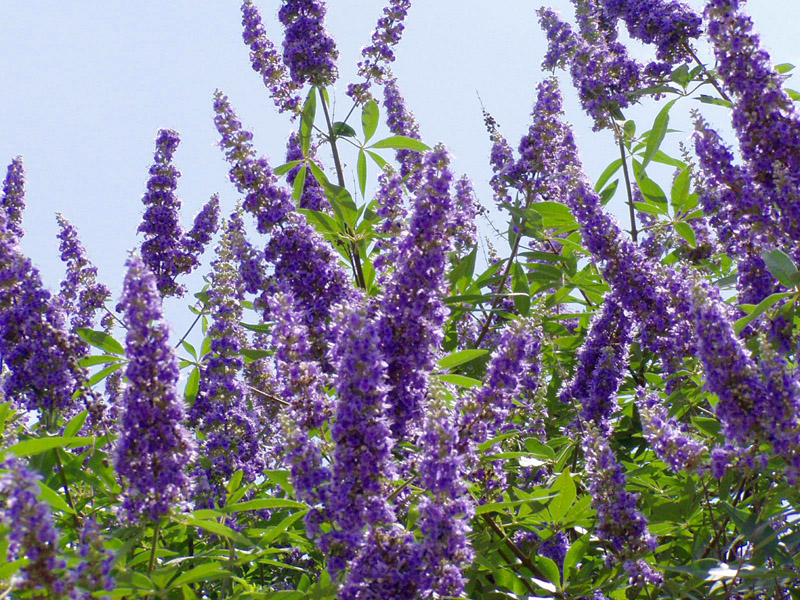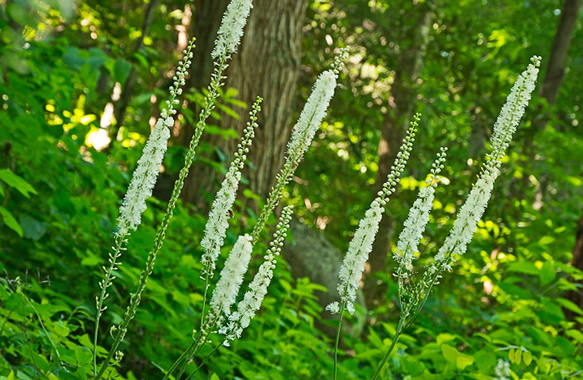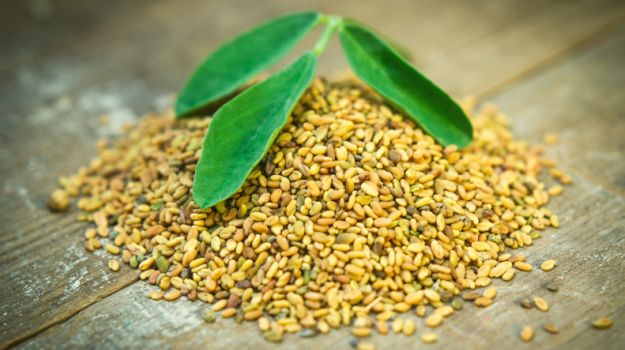Chaste tree berry
Chasteberry (Vitex agnus-catus) is a small brown berry fruit of the chaste tree which is about the size of peppercorns and smells like peppermint. Chasteberry has been used for medicinal purposes for centuries for its health benefits. In its ripe form, the fruit is used in the preparation of herbal liquids and powdered extracts. The fruit is also known as vitex, monk’s pepper, or monk’s berry as it was used by ancient Romans to curb the sexual urges in monks.
Chaste tree berry from ancient times into the 19th century, Europeans believed (incorrectly) that the small, dark, peppercorn-like fruits of this shrub suppressed women’s libido, hence the name. Chaste tree was first associated with women’s breast by the ancient Greek physician, Dioscorides, who recognized its effect on the female reproductive system, notably the herb’s ability to increase milk production in nursing mothers.

Modern research has shown that chaste tree affects the pituitary gland, increasing production of luteinizing hormone and decreasing secretion of follicle-stimulating hormone. These changes, in turn, affect the balance of women’s sex hormones, estrogen and progesterone, reducing estrogen level and increasing the level of progesterone. These changes don’t enlarge breasts, but they help treat premenstrual syndrome. In fact, chaste tree has become THE herb for PMS.
The herb Vitex agnus-castus, also known as monk’s pepper or Chasteberry, is the fruit of the chaste tree. According to the American Family Physician, due to the effects chasteberry has on various hormones, particularly progesterone and prolactin, it has been used for centuries to treat many different hormone-related gynecologic conditions. Vitex agnus-castus may be helpful for some health conditions, but consult a doctor before starting any supplement program.
Women who suffer with premenstrual syndrome, commonly called PMS, experience a number of symptoms, both emotional and physical, every month from two to 14 days before their menstrual cycle. Typical symptoms include headaches, depression, stomach cramps, breast tenderness and mood swings. According to the University of Maryland, PMS may be due to high levels of estrogen or a deficiency in progesterone.
In a study published in a 2000 issue of the “Archives of Gynecology and Obstetrics,” researchers found Vitex agnus-castus helped to improve the symptoms of PMS. The University of Maryland recommends 400 mg of a standardized extract of Vitex agnus-castus daily before breakfast to help PMS. Women who suffer with PMS should consult a doctor before taking any Vitex agnus- castus supplements.
A German company has used Chasteberry extract in the manufacturing of a medication for Mastalgia – sore breasts or breast tenderness associated with PMS (Pre-Menstrual Syndrome) and menopause. It is believed that Chasteberry extract may help stop the release of a hormone prolactin from the pituitary gland. High levels of Prolactin hormone may stimulate milk production in pregnant and lactating women causing breast tenderness and may also cause irregular menstrual cycles and missed periods. Therefore, taking one 300mg Chasteberry extract capsule daily can be beneficial to reduce breast tenderness.
Chasteberry is often used by herbalists to regulate hormone imbalances in women and lower the testosterone levels in men. It is known for its effectiveness in the treatment of menstrual disorders, PMS, menopausal symptoms such as breast tenderness, hot flashes and mood swings, infertility and decreased milk production in lactating women. Due to its anti-androgen activity, Chasteberry has been used as a natural supplement to lower testosterone levels in transgenders (in male to female), and to suppress the onset of prostate cancer which is also associated with high testosterone levels. Its anti-androgen activity may also help clear up acne, reduce Hirsutism (excessive hair growth) in women.
Black Cohosh
Since it is believed to help with postmenopausal symptoms, and raise low estrogen values, it is supposedly able to have breast-enlarging properties. However, according to the National Center for Complementary and Alternative Medicine, it is said that Black Cohosh may have negative effects on liver when taken in a larger amount. It is rarely established that the herb has adverse effect in most people.

If you notice abdominal pain, dark urine, and jaundice from taking Black Cohosh, discontinue the use immediately. It is a bit tricky to pinpoint what is too much as the needed dosage varies from person to person. Generally, you do not want to exceed 80 milligrams per day. More importantly, you do not want to take the herb with alcohol.
Back Cohosh (Cimicifuga racemosa) owes its medicinal action to several compounds in its root (aceteine, formononetin, and triterpenes). In the 1940’s, German scientists discovered that these compounds act like estrogen. By the 1950s, a commercial extract of black cohosh, Remifemin, was used widely in Germany as a treatment for PMS, menstrual cramps, and hot flashes of menopause. Reminfemin is now available in the U.S.
But recent research shows that it’s not truly estrogenic. Black cohosh suppresses secretion of luteinizing hormone (LH) secreted by the pituitary gland. LH is involved in the menstrual cycle, menopause, and female reproduction, so black cohosh has effects that appear estrogenic, but it’s action is different, so it can be used by women who can’t take estrogen. These days, black cohosh is not widely touted for breast enhancement.
Black Cohosh has been used by Native Americans for more than two hundred years, after they discovered the root of the plant helped relieve menstrual cramps and symptoms of menopause. These days it is still used for menopausal symptoms such as hot flashes/flushes, irritability, mood swings and sleep disturbances. It is also used for PMS, menstrual irregularities, uterine spasms and has been indicated for reducing inflammation associated with osteoarthritis, rheumatoid arthritis and neuralgia.
Herbal researcher Dr. James Duke has this to say about Black Cohosh; “Black cohosh really should be better known in this country, especially with our aging population and the millions of women who are now facing menopause. Recognized for its mild sedative and anti-inflammatory activity, black cohosh can help with hot flashes and other symptoms associated with that dramatic change of life called menopause. It’s also reported to have some estrogenic activity. Herbalist Steven Foster refers to a study that compared the effects of conventional estrogen replacement therapy with black cohosh. That study looked at 60 women, younger than 40 years old, who had had complete hysterectomies and were experiencing abrupt menopause. In all groups, treatment with black cohosh compared favorably with conventional treatment.”
“Native Americans used the roots and rhizomes of this member of the buttercup family to treat kidney ailments, malaria, rheumatism, and sore throats. Early American settlers turned to it for bronchitis, dropsy, fever, hysteria and nervous disorders, lumbago, rattlesnake bites, and yellow fever. It’s also reportedly well known for easing PMS and menstrual irregularities.”
This estrogenic activity, notes Dr. Duke, can contribute to a ‘mastogenic’ effect; the natural enlargement of the breasts. Black Cohosh has also been used to induce labour and should not be used during pregnancy.
A dozen studies or more conducted throughout the 1980s and 1990s confirm that the long-standing use of black cohosh for menopausal symptoms has scientific validity. For example, in a German study involving 629 women, black cohosh improved physical and psychological menopausal symptoms in more than 80% of the participants within four weeks. In a second study, 60 menopausal women were given black cohosh extract, conjugated estrogens, or diazepam (a leading anti-anxiety medication) for three months. Those who received black cohosh reported feeling significantly less depressed and anxious than those who received either estrogens or diazepam. In another study, 80 menopausal women were treated for 12 weeks with black cohosh extract, conjugated estrogens, or placebo. Black cohosh improved anxiety, menopause and vaginal symptoms. In addition, the number of hot flashes dropped from 5 to less than 1 average daily occurrences in the black cohosh group compared to those taking estrogen in whom hot flashes dropped from 5 to 3.5 daily occurrences.
Given these examples, and results of other studies, some experts have concluded that black cohosh may be a safe and effective alternative to estrogen replacement therapy (ERT) for women who cannot or will not take ERT for menopause.
Preliminary studies also suggest that black cohosh may help reduce inflammation associated osteoarthritis and rheumatoid arthritis. In a review of scientific studies, researchers concluded that a combination of black cohosh, willow bark (Salix spp.), sarsaparilla (Smilax spp.), guaiacum (Guaiacum officinale) resin, and poplar bark (Populus tremuloides) may help relieve symptoms of osteoarthritis.
Fenugreek
Herbalists believe that fenugreek can help increase breast dimension as well as make them firm. Being a phytoestrogenic herb, fenugreek stimulates the breast-enlarging hormones like estrogen and progesterone. Additionally, it can help increase milk production in nursing mothers.

Mix one-fourth cup of fenugreek powder with a little water to make a paste. Apply the paste on the breasts and massage gently. Allow it to sit for 10 minutes and then rinse it off with water. Follow this remedy twice daily for best results. Another option is to daily masage your breasts with fenugreek oil, or a mixture of one part fenugreek extract and two parts body lotion. You can also include fenugreek sprouts in your diet or take fenugreek in the form of pills three times a day after consulting your doctor.
Most women that want to make their breast bigger know that fenugreek can possibly help them. However, they still want to know how does fenugreek increase breast size. A woman’s breast will grow at different times in their life, which includes right before birth, during puberty, and while they are giving birth to a child. Some women might also experience some development in their breast size while they’re going through menstruation and when they reach menopause.
The fetal development is when your breasts will start to form. The mammary ridge or milk line in your breasts will begin to thicken. The first to develop are the small lobes of breast tissue. The next area in your breast to develop are mammary glands, which are made up of up to 24 lobes. These lobes in your mammary glands will begin to develop due to hormones that will start to stimulate it during puberty. Your mammary glands will start to shrink by the time you reach thirty five years old.
When you reach your adolescent years you are supposed to start noticing your breasts are growing in size. Fat inside the connective tissue starts to build up making the breasts get bigger once the ovaries begin to secrete estrogen. Fenugreek is a herbal plant from India and the Mediterranean area. The seeds derived from this plant has been known to help with a variety of different health problems, especially when it comes to women’s health. If you wanted to know does fenugreek increase breast size the answer is yes.
The way fenugreek helps with breast development is by stimulating your mammary gland, which will help your breast tissue to grow and expand. It’s the phyto-estrogen naturally found in fenugreek that will help increase the level of prolactin (female estrogen) in your body.
You can use fenugreek for breast enlargement in a number of ways. The most common way to use fenugreek to increase breast size is to take herbal capsules. Fenugreek capsules can be found in pretty much any healthy food stores. Take at least 1 capsule each day and then increase the dosage as time goes on.
You can also use fenugreek to make your breast bigger by using it in its liquid herbal extract form. Head to your local health food store and then apply the herbal oil on your breasts as you massage it in. Apply the fenugreek extract by doing a circular motion with your hands around your nipples.
The extract will get absorbed by your body, while the circular motion of the massage will help to increase the amount of blood circulation in the breasts. Getting more blood flow is also a very important factor when it comes to breast enlargement. Keep in mind you’ll need to perform this massage technique a few times daily for about 4 months to experience 1 to 2 cup increase.
If you ever wondered does fenugreek increase breast size the answer is yes. However, when you take the fenugreek herbal supplement if you don’t see any improvement within a 6 month period it might be wise to discontinue taking them. Your body isn’t meant to keep such a high level of estrogen because it might cause cancer or other complications.
Fenugreek has a long history as a breast enlarger and contains diosgenin which is used to make synthetic estrogen. It has been found to promote the growth of new breast cells and increase the size and fullness of the breasts. Of all the herbs used for breast enlargement fenugreek has the highest concentrations of the effective plant compounds. Diosgenin, a steroid sapogenin is the starting compound for over 60% of the total steroid production by the pharmaceutical industry. Other sapogenins found in fenugreek seed include yamogenin, gitogenin, tigogenin, and neotigogens.
While Fenugreek is considered the finest herb for enhancing feminine beauty it also aids in sexual stimulation, balances blood sugar levels, and contains choline which aids the thinking process. Fenugreek has been the focus of several studies concerning the treatment of diabetes and the prevention of breast cancer. Its ability to balance hormone levels aids in treating PMS and menopause. Its antioxidants slow ageing and help prevent disease.
The plant has also been employed against bronchitis, fevers, sore throats, wounds swollen glands, skin irritations, diabetes, ulcers, and in the treatment of cancer. Fenugreek has been used to promote lactation and as an aphrodisiac.
Fenugreek contains an amino acid called 4-hydroxyisoleucine, which appears to increase the body’s production of insulin when blood sugar levels are high.
Higher insulin production may decrease the amounts of sugar that stay in the blood for many individuals. In some studies of animals and humans with both diabetes and high cholesterol levels, fenugreek lowered cholesterol levels as well as blood sugar levels.
However, no blood-sugar lowering effect was seen in non-diabetic animals. Similarly individuals with normal cholesterol levels showed no significant reductions in cholesterol while taking fenugreek.
Fenugreek contains an amino acid called 4-hydroxyisoleucine, which appears to increase the body’s production of insulin when blood sugar levels are high. Higher insulin production may decrease the amounts of sugar that stay in the blood for many individuals. In some studies of animals and humans with both diabetes and high cholesterol levels, fenugreek lowered cholesterol levels as well as blood sugar levels.
Some evidence suggests that fenugreek may also have other medical uses. It may reduce the amounts of calcium oxalate in the kidneys. Calcium oxalate often contributes to kidney stones. In animal studies, fenugreek also appeared to lessen the chance of developing colon cancer by blocking the action of certain enzymes. Topically, the gelatinous texture of fenugreek seed may have some benefit for soothing skin that is irritated by eczema or other conditions. It has also been applied as a warm poultice to relieve muscle aches and gout pain.
Fenugreek includes “saponins” which often reduce the assimilation of the awful cholesterol. In the human body, soaked up Fenugreek substances develop a fiber nearly the same as mucilage, supplying a priceless “stickiness.” The Fenugreek vegetation can provide achievable advantages in blood sugar levels and the entire body weight reducing. Fenugreek intake tends to increase breasts size and milk generation generally for the nursing mothers.
Disclaimer
The Content is not intended to be a substitute for professional medical advice, diagnosis, or treatment. Always seek the advice of your physician or other qualified health provider with any questions you may have regarding a medical condition.